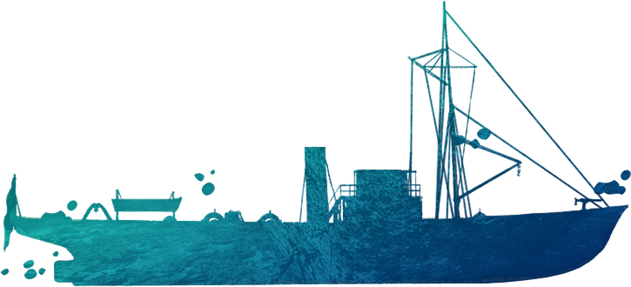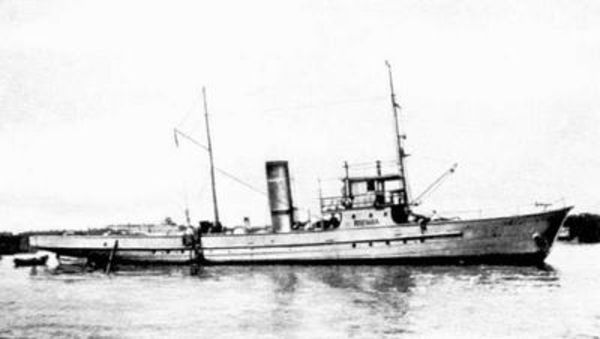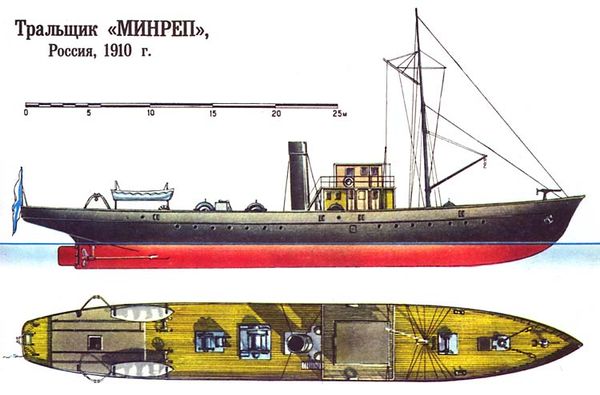Vzryv and Provodnik

Technical data
- Class: Minrep
- Displacement: 150 tonnes
- Length: 45.1 meters
- Crew: 2 officers, 29 enlisted
- Armament: 2 x Shultz sweeps, 1 x Shestrand anchor sweep, 1 x serpentine sweep; 1 x 57 mm gun, 1 x 7.62 mm machine gun, 50 obstacle mines (in overage)
- Sank in 1914 in the Gulf of Finland
- Discovered and preliminarily inspected by our team in 2014
- Depth: 65-70 meters
Ship histories
The Russian-Japanese war of 1904-1905 gave a number of lessons that significantly influenced shipbuilding trends, the commissioning of new classes of warships, as well as the focus of fleet combat training and countermine operations.
One of the lessons learned led to the creation of the world’s first specially designed countermine ships – minesweepers.
In 1907, a commission was created to develop suggestions for using mines in warfare. The commission noted that Russia left much to be desired in this area. Based on the commission’s recommendations, the Naval General Staff decided to build specially designed minesweeper ships for the fleet. Vice Admiral I.K. Grigorovich, a supporter of developing domestic naval shipbuilding capabilities, dispatched an order for the construction of the new minesweepers to the state-owned Izhora Shipyard. It was also charged with the project’s design. The first two minesweepers, named Vzryv and Minrep, were laid down in December 1909.
The world’s first specially designed minesweeper, Vzryv, slipped its berth on 17 March 1911, followed on 6 April by Minrep, which would become the lead ship of the class. Before their trials had ended, on 12 June 1910, the Izhora Shipyard received an order to construct three additional minesweepers based on the Vzryv’s design and specifications: the Zapal, Provodnik and Fugas.

In the early years of WWI, during 1914-1918, minesweeper operations mostly involved piloting ships behind sweeps in the Gulf of Finland and Baltic Sea.
The lessons learned in the first months of combat operations showed that Minrep-class minesweepers handled well, were seaworthy, and easily withstood rolling and pitching. That said, they had a short cruising range and weak engines. This limited their use in fresh weather and remote areas.
The ships’ undoubted advantage was their high survivability, of which the Vzryv minesweeper serves as an excellent example.
Sinking
Minesweeping operations are associated with constant risk and losses are inevitable. The Minrep-class minesweepers were no exception.
The Provodnik minesweeper had the dubious glory of being the first ship of the Russian Imperial Fleet to sink in WWI. It happened on 27 August 1914 while sweeping the first minefield deployed by the Germans at the mouth of the Gulf of Finland.
Description of the event by I.A. Kireev, staff navigator of the Baltic Fleet’s minesweeping division:
«The Provodnik cleared three mines, one after another. At the same time, the Zapal cleared one mine, after which its sweep ceased to serve as a reliable cover for the Yakor, which was following in its wake. At any rate, this was spurious cover at best, because the swept path ran at an angle to the heading due to the drift, and the left-front line minesweeper was basically sailing without cover. Despite their large draft, the second-line minesweepers safely cut through two lines of mines. The second pair struggled to advance, towing the mines that had been swept. From all sides, the short, sharp whistles that the minesweepers used to report about mines they had swept could be heard. Kitkin, who was on board the Iskra, ordered the Provodnik to approach to cut the mines that had been caught by the first pair; at the same time, he decided to interrupt the minesweeping operation and lead the minesweepers to clear water. On the Iskra, he had the false impression that the mine barrier followed a NW-SO orientation, so instead of turning to the port side, he signaled both lines to turn to the starboard side, not knowing that in doing so they would have to cross the barrier line. While performing this maneuver, at 15:45 the Provodnik in its turn hit a mine on the starboard side, against the stokehold. The explosion damaged the minesweeper severely: the bridge was destroyed, the pipe and mainmast were blown off, and the side had a huge, gaping hole. The loss of life was very high: of the 30 crew members, 11 were killed and 7 were injured. The minesweeper remained afloat for 15 minutes after the explosion: at first she tipped to starboard, then straightened up, sagged in the middle, and broke in two. The Zapal, Minrep, Yakor and Prochny launched dinghies to rescue her crew.»

The second of the first run of ships to sink was the first minesweeper of the class that was built: the Vzryv.
I.A. Kireev’s description of the Vzryv’s sinking follows:
«Today (appr. 28.05.1916), while establishing the westernmost line of the Forward Mine Position, a disaster took place on the Vzryv minesweeper. It had already deployed 30 mines, but while launching the 31st mine, a poorly secured protective device hit the explosive cutter along the edge of a slot on the stern skirting and exploded. The explosion detonated the mine. There was a deafening blast and a huge column of flame and black smoke rose up over the minesweeper’s stern. The minesweeper continued along its course, then stopped about a minute and a half later; people who had been thrown overboard from the stern by the explosive gasses were swimming in the water. The Fugas was already far behind, and the flagship minesweeper ignored its instructions. Turning sharply to starboard, the Zapal headed toward the stricken ship; the Minrep did the same, without being ordered to do so. Minesweepers 17, Sheksna, Mologa and 16 stopped their engines. The Fugas, as well as minesweepers 14 and 15, immediately turned around following the explosion and sailed full speed toward the accident. At the time of the explosion, 20 of the 38 crew members were on the stern; they were all killed except for one minelayer, Markin, who was thrown into the air by the explosion and landed in the water far astern the minesweeper. Subsequently, doctors extracted about 150 tiny bits of shrapnel from his body, and he quickly recovered.
The most incredible thing is that he was standing the closest to the explosion. The dinghies rescued four wounded from the water and took 14 survivors off the Vzryv (of whom another two were wounded). Immediately afterward, another mine exploded on the minesweeper’s deck, and the remaining three mines were smoking; one of them had been thrown by the explosion and lay on its side on the engine compartment hatch. Frequent explosions from cartridges stored in the mine cabin could be heard, the stern was on fire, the round-aft was smashed, the ship’s skin was torn off in places and bulkheads were jutting outward. The Minrep unsuccessfully tried to extinguish the fire. Kovalevsky, who had approached on the Fugas, was ordered to tow the Vzryv to the west of the barrier line and use the good firefighting equipment on board minesweeper 15. The wounded were transferred to minesweeper 14 and sent to Hanko. The Fugas towed the burning Vzryv a long time, but minesweeper 15 was unable to extinguish the fire. An hour and a half after the initial explosion, first one and then the other two smoking mines exploded, the bow lifted into the air, and the minesweeper swiftly sank.»
Summary
The Provodnik was the first ship of the Russian Imperial Fleet to sink in WWI. The Vzryv sank while establishing the Forward Mine Position, which sealed the entrance to the Gulf of Finland tightly shut in 1916, and it was at this minefield six months later that the Russian Baltic Fleet would enjoy its largest victory – in one night, seven of Germany’s newest destroyers sank after hitting mines in the Forward Mine Position’s trap.